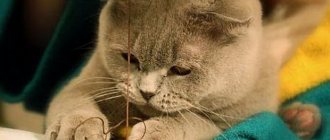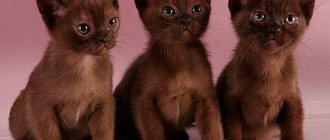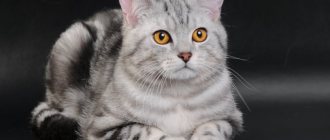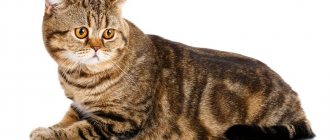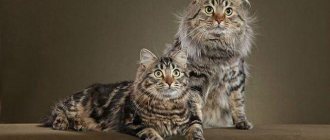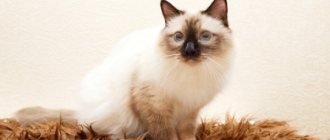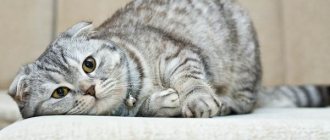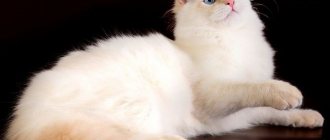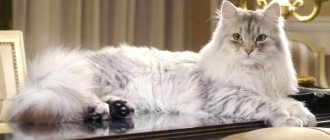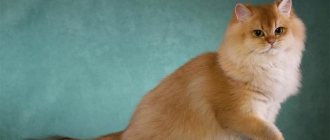Cat breeds bred by UK felinologists are deservedly popular. Both amateurs and professional breeders appreciate the elegance and friendliness of these pets. The modification of the Scots with a characteristic golden color got its name due to the similarity of color with a rodent of the chinchilla family. These uniquely colored pets are not yet very common due to a combination of unfavorable factors. The golden chinchilla cat breed - these representatives are descendants of exotics and Persians, therefore among these cats there are specimens with both long and short hair.
Origin story
The British cat breed was formed at the end of the 19th century, although it took about a hundred years for the official registration of a breed standard. Careful selective selection allowed us to obtain pets with stable health and good character. Many British were born in England, but additional selection of sires was often carried out in Europe or America.
The category of Golden Chinchillas (short-haired, long-haired) appeared as a result of mixing the genetic material of Persian chinchillas and cats with monochrome colors, or British cats with a smoky color.
Photo - Golden chinchilla
The main disadvantage of the offspring resulting from the cross was the lack of stable eye color, ranging from turquoise to yellowish. To stabilize the color of the iris, breeders tried crossing with tabby cats with emerald green eyes. However, such attempts often led to changes in the color of the cats' skin. Therefore, the tactic of inbreeding cats, interspersed with the infusion of Persian genes, was chosen.
The development of the golden cat breed was carried out in accordance with the principles used to produce silver cats. The starting point was an already formed variety of silver chinchillas, and the result was achieved thanks to the gene responsible for the “golden” shade of coat obtained from the Persians.
Long-lived domestic cats
The record holder for life expectancy is a cat named Lucy, who lives in the UK. According to official data, she is 43 years old. Translating to our human age, it turns out that the cat is almost 175 years old. In second place is the cute cat Cream Puff, originally from the USA, who lived a happy life at the age of 38, leaving this world in 2005.
Well, in third place among long-livers among mustachioed fluffy pets is a cat who once lived in Devon (England). He lived happily until his 36th birthday, after which he calmly passed away. By the way, the mentioned animals are Guinness Book record holders in the section of long-livers among domestic cats.
Description of the breed
Golden seals today are in great demand among buyers who are not very versed in the differences. In fact, golden-colored cats may belong to the British or Scottish breed with straight (straight) or fold ears (fold), or to Persians, from which the British inherited the golden color about 50 years ago.
Felinologists studying the causes of the rare coat color have not yet come to a unanimous conclusion. To date, no genetic test has been identified that can link the genome of an animal with the golden color of the skin.
To establish breed characteristics, scientists use a visual comparison technique that takes into account the following characteristics:
- The guard hairs of the coat have a zonal color, with the lower level being colored the color of a ripe apricot. Thanks to this, the pet's undercoat has a light orange tint.
- The upper zone of the guard hairs is colored black in certain proportions (half for tabby colors, one third for shaded colors, 12.5% for chinchillas).
- At the end of the tail, paw pads, nose, lips and corneas of the eyes, the base color predominates.
The most valuable representatives of the breed are distinguished by the maximum saturation of each hair with a bright yellow color. Since many individuals have orange undercoats of varying degrees of brightness, breeding cats with the “golden” gene is particularly difficult, given that the desired gene is not completely dominant, and recessive traits cannot be completely suppressed.
An example is the crossing of specimens with golden and black tabbies, the descendants of which have a gray undercoat and orange guard hairs. The eyes of such kittens are most often colored light green. Thus, to obtain a kitten with the correct golden color, it is necessary that both sires belong to this type.
Quite often, animals with a silver color are used in breeding work, provided that among the ancestors there are the colors of a real Golden Chinchilla. Based on these conditions, British breed chinchillas can be silver, with a hint of silver, or golden, but provided that at least 12.5% of black is present in the upper part of the guard hairs.
Silver or Golden cats are distinguished by bright green eyes, while pets with a silver tint may have slightly yellowish eyes. The breed standard allows small black spots, including charcoal paw pads, dark edging of the nose and eye.
The standards allow partial coloring of the cat, when the upper surfaces of the pet’s body are darkened, and the tummy, chest and chin shine with golden shades.
The remaining distinctive features must fully coincide with the standards provided for British cats: developed muscles, powerful neck, flat back, large hips, powerful paws, wide tail with a curved tip.
Males of this species can be easily identified by their rounded cheeks. Like other British cats, cats are distinguished by round, expressive eyes and dense, thick fur.
Summarizing the characteristic features, Golden Chinchillas can be characterized using the following characteristics:
- powerful build, muscular chest, straight back;
- limbs of medium length;
- round paw pads with woolen bushes between the toes;
- small head with a rounded chin;
- a flattened small nose, colored pink or brick;
- large eyes with a greenish-copper iris, outlined in dark (the point chinchilla has blue);
- short straight ponytail, rounded at the end;
- weight from 4.5 to 8 kg.
In recent years, the original variety of Golden Chinchilla – “point”, which is characterized by deep sapphire-colored eyes outlined with a charcoal “tattoo”, as well as black paw pads and nose, has enjoyed increasing success. Such signs are explained by the fact that the Golden Point Chinchilla belongs to black cats. At the same time, cats in this category can be classic chinchillas, or have a shaded color the color of baked milk.
Psychological picture
Let's move on from the description of external data to the character of chinchilla cats. Here are its main features :
- unobtrusiveness;
- love of freedom;
- sensitivity;
- calm;
- friendliness;
- self-sufficiency.
Silver British chinchilla, Persian and fold are real aristocrats. They will decorate any home, even if we are talking about royal apartments. It’s not for nothing that chinchillas constantly lived with Princess Victoria, thanks to which, by the way, they gained such wild popularity.
An aristocrat cat knows his own worth, but at the same time respects others. He will never allow himself such “plebeian” antics, such as, for example, waking up a sleeping owner with a heart-rending scream demanding food, or jumping on him from a running start, wanting to play. No, it’s the yard Vaska who can behave this way, and the silver Marquise will sit quietly on the sidelines and patiently wait for her to wake up.
Chinchilla cats are quite self-sufficient and are able to entertain themselves. However, they will not refuse the owner’s attention and will happily curl up in a ball on his lap, exposing their luxurious fur for stroking. They will respond to affection with a pleasant purr. Another important advantage of chinchillas for many is their silence. Cats will not meow with or without reason.
Silver beauties do not like it when their freedom is limited and forced to do what they do not want . In the house, these cats should have a personal space that no one can encroach on. If you fulfill these simple requirements, your chinchilla will delight you with friendliness or, at least, tolerance.
She will be patient with children's pranks. She will not release her claws if she is pulled by the tail, but will simply try to carefully free herself and walk away. He will find a common language even with a dog. The only thing he won't tolerate around him is other cats. Such is her psychological peculiarity.
© shutterstock
With the appearance of a silver chinchilla, the house immediately becomes somehow cozier and calmer. This cat is simply the embodiment of regularity, unhurriedness, and impressiveness. At the same time, she doesn’t even mind playing. She just does everything in moderation, without excesses; after all, she is a true aristocrat and one of the most intelligent creatures on the planet.
Temperament
Golden Chinchillas are distinguished by a truly aristocratic temperament and restraint. These pets show dignity and noble manners from a young age. It won't be difficult to train your cat to use the litter box. These fluffies respect the right of their owners to a peaceful morning sleep and are able to satisfy basic needs without disturbing the rest of the family. Representatives of the breed get along well with other inhabitants of the house, including feathered and four-legged residents.
Seals also build harmonious relationships with young residents of their homes. If children bother your furry pet too much, the cat will simply hide in a secluded corner without showing the slightest aggression.
The basic character traits of the breed are stubbornness and independence. The cat reacts with hostility to all attempts by people to limit freedom of movement or move the boundaries of their individual territory.
Pet character
The Scottish Chinchilla is flexible and friendly, but sometimes wayward. The animal is curious and quickly becomes attached to its owner. Since the Scottish Fold is friendly and peaceful, it gets along well in families with children and other pets. The cat gets along well with dogs, but birds leave him indifferent. At the same time, the cat is playful, so the owner should purchase a sufficient number of toys for him. It is recommended to equip a house and climbing frames indoors. These devices will entertain the cat while the owner is at work. The Scottish Fold loves to meow, but does it unobtrusively. It tolerates loneliness normally, but in the company of its owner it shows maximum love and affection.
Conditions and care
Like most other cats, Golden Chinchillas need physical activity, so they will gladly accept the owner’s invitation to warm up and take part in the game process.
To entertain a cat, you should accustom your pet to a scratching post from childhood. Such a device can be purchased in a store or made by yourself.
To maintain the quality of the coat, it is recommended to comb your pets weekly. Long-haired cats need to be treated more often. During bath procedures, you need to use special shampoos recommended by a veterinarian.
Ear inspection and cleaning should be done regularly. To keep your cat's teeth in good condition, you need to periodically offer the animal solid food.
Nutrition
What to feed? Like many others, cats of this variety can eat natural food or prepared food.
When choosing natural food, it is necessary to include dairy products, meat, cereals, and chopped vegetables in your cat’s diet. It is recommended to chop the protein ingredients and put them in boiling water before use. Fermented milk products should be included in the menu 1-2 times a week. It is better to exclude unleavened milk from the diet.
When choosing ready-made mixtures, you should take into account the pet’s physiology: weight, age, health status. The animal should be offered food twice or thrice a day. You need to remember about vitamin and mineral supplements.
Price
If you decide to buy a kitten, it is better to do it in a large nursery, this way you will definitely protect yourself from deception. In addition, the seller will continue to advise you regarding care and maintenance. The cost depends on the class, there are three in total.
A pet, usually purchased only for the soul, will cost you about thirty thousand rubles. Such individuals do not have a stellar career, but they are just as sweet and attractive as others, they just have deviations from the standard.
Breed, any representative of which can participate in exhibitions, costs approximately fifty thousand.
Show - the cats belonging to it are descendants of medalists and will definitely win awards in various competitions. They have a price of about seventy thousand.
Health
Modern felinologists offer several options for the origin of British breed cats with the Golden Chinchilla color. American and British breeders are vying for the lead in the struggle to create the breed.
Despite all the differences in opinions, the fact remains undeniable that pets with a gorgeous golden hue to their skins have good immunity and resistance to adverse environmental factors.
Factors influencing a cat's lifespan
Environment – the longest living cats are those that do not go outside at all or do so under their owner’s supervision. An outdoor cat is subject to constant stress and physical danger:
An ordinary cat living on the street is forced to constantly fight for existence, so its life expectancy is significantly lower than that of a domestic cat. It happens that the owners of a domestic cat easily let it go outside alone. A domestic cat is much more at risk than an outdoor cat, because it is not used to surviving in such conditions. A stray cat is adapted to life on the street and has excellent reactions, unlike a relaxed cat that was raised at home.
Those pets who do not leave the apartment are protected by the walls of the house - they do not freeze in winter, do not get wet in the rain, have fresh food and water, toys and the love of loved ones.
How to buy a kitten
How much does a kitten cost? The price of each Golden Chinchilla cat is determined depending on many parameters: gender, ear shape, color (ticked or not), purpose of purchase (for home, exhibition or breeding). Pedigree, health status, and the results of genetic testing are also taken into account.
Kittens intended for exhibition or breeding work are valued at several thousand dollars, since they are exclusive specimens. Seals that will not be used for breeding are offered for $400-600.
Ticked chinchillas
Fold cats are ticked and shaded in color. Let us briefly explain the meaning of these terms, since they often cause misunderstanding among ordinary amateurs.
With ticked (otherwise known as Abyssinian) color, each hair of a cat's fur is divided into several colors (usually two or three). When moving, such an animal seems to iridescent - at different angles it appears a slightly different color. The general appearance of this color is a light “veil”. By the way, there is no ticking on the stomach and chest, as well as on the inner sides of the legs.
Silver fold chinchilla kittens are born more often than other shades. Therefore, the color options for chinchillas are as follows: either white (silver), or gold or blue gold. By the way, the latter is the rarest color not only among this species, but also among Scottish fold cats in general. By the way, a ticked chinchilla kitten is not cheap.
